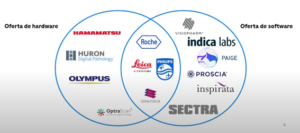This second secondment at ROCHE allowed us to go a step further in the field of digital pathology
During the month of March 2022, three ESRs from CLARIFY did a virtual secondment at ROCHE Diagnostics S.L.U. In this blog post, Claudio (ESR6), Laëtitia (ESR7) and Andrés (ESR12) will tell you all about this secondment and about what they learnt.
This virtual secondment was divided into both synchronous and asynchronous workshops. The synchronous one consisted in a workshop with a Digital Pathology expert from ROCHE, whereas the asynchronous part, consisted in pre-recorded seminars about different topics related to traditional and digital Pathology.
Synchronous Workshops
During the first day of the synchronous workshop, Claudio, Laëtitia and Andrés, gave half-an-hour presentations about their progress and objectives during the last year, since the previous secondment at ROCHE. This session had the objective of getting to know each other and updating the professionals from ROCHE about the topic and the status of our projects.
The presenter of the next session was Alejandro Garcia Torrado, expert in Digital Pathology at ROCHE Diagnostics, who gave a presentation about the status of Digital Pathology in Spain and the world from an industrial point of view. During this session, Alejandro explained that currently Digital Pathology as a technology is in the state of the Early Adopters nowadays, as it is starting to appear interesting for investors and the first funding agreements are also happening. In this sense, he also presented the main actors working on Digital Pathology both in terms of hardware and software. He also introduced the main challenges that this technology is facing nowadays in terms of technology, prices, and regulation. Regarding the regulation, he explained the differences between the In Vitro Diagnostics (IVD) and the Research Use Only (RUO), concluding that nowadays the regulation of Artificial Intelligence algorithms for Pathology is not enough and there is a need for regulatory proposals, which are currently led by the USA.
On the other hand, at a commercial level, Alejandro explained the current rise on the interest for computational pathology in research during the last couple of years. Also, related to the commercial level there exist the difference between closed and open algorithms approaches, which depend on the possibilities for changing the algorithm after it is sold. He also described the landscape of companies working on commercial Digital Pathology solutions in both hardware and software sides (Figure 1).
Figure 1. Example of companies involved in Digital and Computational Pathology.
During the second day, Alejandro showcased to us uPath, which is an image analysis software original from ROCHE Diagnostics. This software allows the users to upload WSIs from either H&E slides or immunohistochemistry (ICH) slides and perform several image analysis techniques using image processing and artificial intelligence. This was very relevant for us in CLARIFY, for both Laëtitia and Claudio who aim to develop algorithms for analyzing WSIs, and for Andrés who is the end-user of AI models’ results through this type of platform. This session ended with a colloquium between the ESRs and Alejandro about these types of tools, their features, and technical particularities.
Additionally, follow-up meetings took place with the secondment tutor where we discussed the contents of the seminars with our supervisors at ROCHE Diagnostics Mr. Carlos Manchado and Ferran Brianso.
Asynchronous Workshops
In parallel, we also watched asynchronous workshops about diverse topics related to clinical and digital pathology, each consisting in a set of several presentations:
- X Annual Review of Pathology and Oncology Conferences of 2021
- Digital Pathology. Defining the future
- Liquid Biopsy Workshop
- The Search for NTRK Fusions – From Discovery to Treatment
Specifically, these asynchronous workshops had a two-fold interest. First, Claudio and Laëtitia could be introduced to a new concept, liquid biopsies, a minimally-invasive analysis of biological fluids that could allow a more accurate representation of the tumor heterogeneity. Regarding the Digital Pathology, the review of the Pathology and Oncology Conferences of 2021 was very interesting as it included the latest advances in the field, also including a space for research using Artificial Intelligence algorithms studies apart from the medical ones. This shows how the medicine community is starting to get more familiar and to become interested in the potential of these automatic models. In this sense, we all could get a broader idea of current and future applications of Digital and Computational Pathology to the clinic, as well as getting a broader perspective of the challenges its implementation might entail.
All in all, this secondment was in line with the first secondment at ROCHE Diagnostics. While the last secondment was an introduction to many concepts for us, this year it allowed us to go a step further, mostly in the field of digital pathology. Indeed, not only could we grasp the meaning of more concepts presented in the different workshops, but we could also directly use ROCHE Diagnostics’ image analysis software through interactive sessions. In fact, one year after the first secondment at this institution, these sessions had a different impact on our perspective and future work in CLARIFY, and its implementation in real-world applications.
Claudio Fernandez, Laëtitia Launet and Andrés Mosquera – ESR6, ESR7 & ESR12


